LEN RAWLE
THE PROFESSIONAL AMATEUR
& ORGANIST SUPREME
-oOo-
PAGE NINETEEN:
INTERVIEWS & FAVOURITES
-oOo-
INTERVIEWS
-oOo-
Over the years, Len has been interviewed multiple times (somewhere between one and two hundred) for television, radio, newspapers and magazines, but perhaps his most memorable were with Judith Chalmers and his involvement in the television production of Metro-Land.
-oOo-
THE BBC INTERVIEW WITH JUDITH CHALMERS
-oOo-
His first interview took place with Judith Chalmers (1935), the radio and television personality in November 1960. Len says that he received a telegram from the BBC, asking him to telephone the Presentation Centre at the Shepherds Bush facility to discuss the following day’s interview at Wurlitzer Lodge.

Len was very impressed by Ms Chalmers and said that she has a wonderfully warm personality and the ability of making the interviewee totally relaxed and fully a part of the support crew. Len adds that she had a wonderful broadcasting voice and on-camera persona and so was well-blessed in that both the camera and microphone liked her. Len says that he enjoyed every moment of sitting with her in the lounge at Wurlitzer Lodge unlike a number of other interviews he had been required to give in broadcasting studios.
-oOo-
Len remembers that Ms Chalmers and the crew arrived just a little late following an afternoon water skiing session for the BBC. Their Land Rover was packed with the crew and all the necessary film kit. What Len recalls the most was the way she responded to the crew’s jokes and banter that made for a most comfortable atmosphere.
Len parents were present off-camera during the interview and got along famously with the crew who enjoyed the cups of tea that Len’s mother happily served them. The whole session proved to be extremely congenial, and when over, no one seemed willing to rush off. In fact, Len adds, that he felt that the crew and Ms Chalmers appeared happy to remain all evening and enjoy sitting and listening to his organ playing. When the time to leave finally dawned on everyone, there was a quick count-up of who was going to travel in which car and in which seat and they took their leave.
Len says that everyone involved in the session got along famously and the whole day turned into yet another one of life’s memorable, and even dare I say, educational experiences.
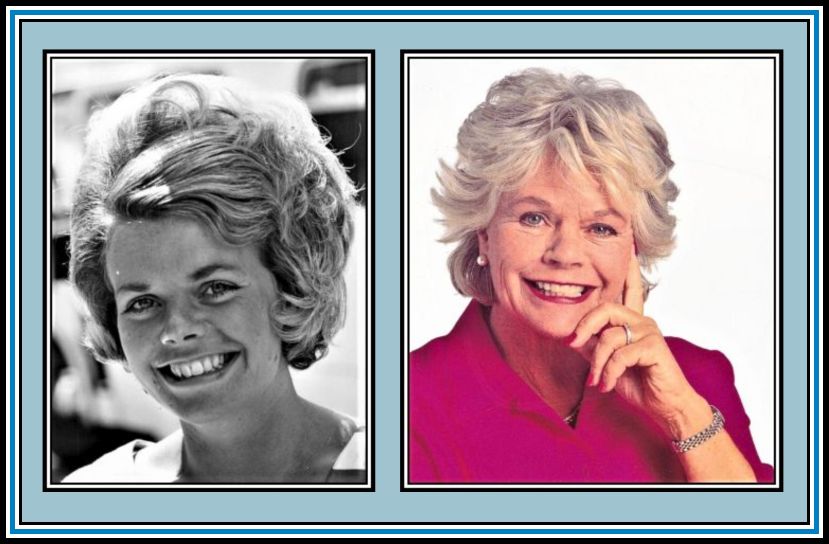 Judith Chalmers who was awarded The Order of the British Empire (O.B.E.) by The Queen in 1994.
Judith Chalmers who was awarded The Order of the British Empire (O.B.E.) by The Queen in 1994.
-oOo-
Although there have been a number of other television company visits to both Wurlitzer Lodge and Tonawanda, perhaps the one that Len recalls most fondly, in addition to that of Ms Chalmers, was that when the BBC came by to film a segment for Metro-land. This programme was presented by Sir John Betjeman (1906-1984) and produced by Edward Mirzoeff (1936 ), and was filmed in 1973.
-oOo-
SIR JOHN BETJEMAN & METRO-LAND
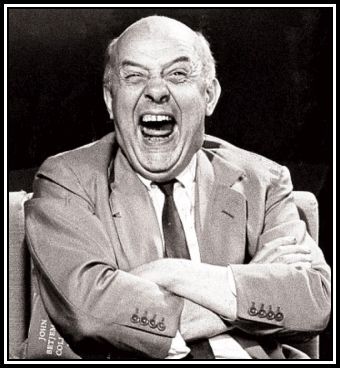
Sir John Betjeman (1906-1984) was a writer, broadcaster and poet. He was Britain’s Poet Laureate from 1972 until his death in 1984 and a founder member and secretary of The Victorian Society. Sir John was directly involved in the saving of a number of remarkable examples of Victorian architecture including Holy Trinity Church, Sloane Street and St. Pancras Station both in London when threatened with demolition in the 1970s.
 Top Left: Holy Trinity Church, Sloane Street; Bottom Left: The Euston Arch
Top Left: Holy Trinity Church, Sloane Street; Bottom Left: The Euston Arch
Right: St. Pancras Station
Sadly, not all of his efforts proved successful, most noteworthy being the Propylaeum (better known as The Euston Arch), which despite public outcry at the plan for demolition, was destroyed in 1962.
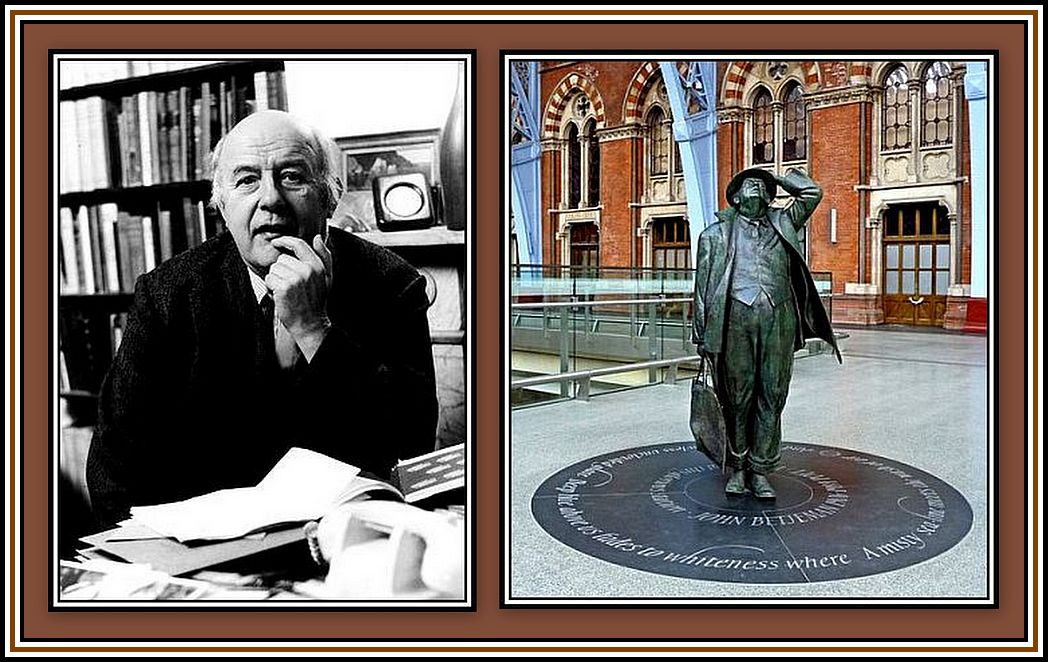 Sir John Betjeman
Sir John Betjeman
Right: Martin Jennings‘ bronze statue on the Upper Level of St. Pancras Station
-oOo-
Although Sir. John grew to be a much-loved and much-admired writer, broadcaster and poet, his life was not without its controversy. In 1937, his work was the centre of criticism when he published a book of poetry containing his poem, Slough.
Sir John was disturbed by the fact that the town of Slough had been used as a dumping ground for war surplus materials in the interwar years and then became home to 850 new factories (known as the Trading Estate) just before World War II. This prompted him to write his poem for which many criticised him. On the centenary of Sir John’s birth, his daughter, Ms Candida Lycett Greene (1942-2014), apologised for the poem and said her father regretted having ever written it.
 Candida Lycett Green & The Plaque to Commemorate Sir John’s 100th Birthday
Candida Lycett Green & The Plaque to Commemorate Sir John’s 100th Birthday
(For those readers wishing to read more of Sir John & Slough, follow the link HERE.)
-oOo-
What perhaps introduced Sir John to the majority of the British public was the BBC documentary production of Metro-land that was first shown on BBC Television on the 26th February, 1973, which has since been repeated a number of times. The production was directed by Edward Mirzoeff (1936), The programme examines suburban life north-west of London, which was developed around the Metropolitan Railway, now part of the London Underground system as part of the Metropolitan Line.
The programme followed St. John’s journey from Euston Station to the proposed terminus of the Metropolitan Railway. When the railway line was in construction, most of the proposed stations were in small villages. One such stop was at Chorleywood, where he and the television crew stopped off to visit Tonawanda where they were treated to some organ music given by Len.
-oOo-
 The cover of the Metro-Land guide published in 1921, which served to promote housing
The cover of the Metro-Land guide published in 1921, which served to promote housing
in the area served by the railway. The guide was published between 1915 and 1932
and was written by Cyril A Wilkinson (1893-1926).
-oOo-
Metro-Land was favourably and warmly received by both viewers and critics. Miles Kington (1941-2008), the journalist and musician, wrote to its producer, Edward Mirzoeff, to say that the programme was just about the most satisfying TV programme, on all levels. Clive James (1939-2019), the journalist, broadcaster and writer, wrote in The Observer, that the programme was an instant classic and predicted that it would be repeated until the millennium. In fact Metro-Land was repeated on BBC Four in 2006 in the same week that the BBC released the DVD of the programme. It has since been shown once more on BBC Four in January 2013 , June 2013 and September 2014. The journalist and co-founder of Private Eye, Christopher Booker (1937-2019) considered it as the best of Sir John’s television programmes. He went to say: like others, I have been endlessly grateful over the years for the more public activities of the other Betjeman. Sir John’s biographer, A. N. Wilson (1950), recalled that Metro-Land was too good to be described simply as a programme.
Click here to read about the origins of Metro-Land
-oOo-
Build a Little House – played by Roy Fox (1901-1982) & His Orchestra
This piece of music was heard as Sir John arrived at Chorleywood on the train
-oOo-
Although there had been many television interviews given at Wurlitzer Lodge and Tonawanda over the years, Len says that the filming of Metro-Land was a truly unique opportunity of being part of a much acclaimed production and that he, Judith and the two children, Elizabeth and Richard, enjoyed the experience very much.
 Judith, Elizabeth & Richard during Sir John’s visit
Judith, Elizabeth & Richard during Sir John’s visit
Len adds that his major recollections of the day of filming concerned the thoroughly professional nature of the entire crew. They were clearly hand-picked by Mr. Edward Mirzoeff, the producer, and took nothing for granted, not even the gallons of tea they consumed! Len found them to be extremely careful with setting-up their equipment (which was very heavy and bulky at the time). Len says due to their care and consideration of their equipment, this was one of the few crews that he allowed into the organ chamber that was filled with a multitude of easily damaged organ pipes.
The crew had been filming elsewhere in the area beforehand coming to Tonawanda and had spent sometime before lunch discussing how to make the visual link between the scenes before and after Len’s contribution.
Sir John was not due until 3 pm, and right on cue, he arrived and walked steadily on the house’s short drive carrying his ever present flimsy plastic bag. He was suffering with Parkinson’s Disease by this time, but had ways of disguising it before the camera. Len says that this is the charming and unassuming vision that he and Judith remember most of Sir John.
 Rear of the Statue at St. Pancras Station of Sir John with his Flimsy Plastic Bag
Rear of the Statue at St. Pancras Station of Sir John with his Flimsy Plastic Bag
-oOo-
Len playing The Varsity Drag during Sir John’s visit to Tonawanda
 Sir John’s Dialogue during his visit to Tonawanda
Sir John’s Dialogue during his visit to Tonawanda
As Sir John entered the house, Len was playing a rhymical little item, The Varsity Drag, on the organ in his lounge. In response to the sounds, his face lit up with the biggest grin. His response was noted by the producer. Mr. Mirzoeff asked Sir John to re-enact the entrance into our lounge complete with happy grin since he believed that this would be an excellent introduction into Len’s part.
 Sir John enjoying the moment as Len played The Varsity Drag
Sir John enjoying the moment as Len played The Varsity Drag
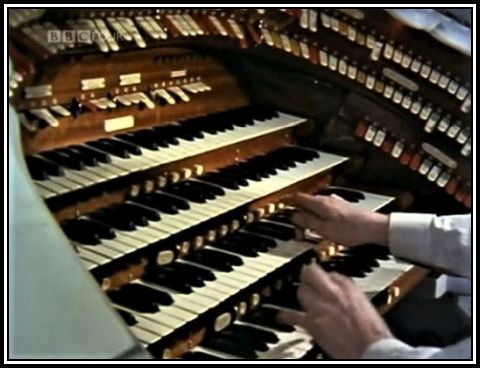 Len playing The Varsity Drag
Len playing The Varsity Drag
 Sir John laughing at the finish of The Varsity Drag
Sir John laughing at the finish of The Varsity Drag
Len says that this moment remains a treasured memory for him and Judith, as well as for the entire crew, since, as Len adds, it revealed the happy and cheeky side of Sir John to an audience that perhaps only saw him as someone only devoted to serious poetry.
Len adds that Sir John was quick to make him feel that following the demise of the grand Empire Theatre auditorium as it once was, he was thrilled to know that he and his colleagues had been able to save its Theatre Organ for future generations to enjoy. That Len was actually able to play the organ also seemed to delight him to such a degree that he could all but dance to the music despite the infirmity imposed by his Alzheimer’s Disease.
-oOo-
Sir John offering the final minute of Metro-Land while Len played Chattanooga Choo Choo
 Len producing the sound of a train starting its journey
Len producing the sound of a train starting its journey
-oOo-
At a rather grand London preview of Metro-land, Len says that he and Judith were again made to feel how worthwhile their endeavours had been. Len adds that it is this that has largely motivated him in his attitude to caring for the few instruments that still remain.
Judith and Len recall Sir John as a truly gentle man with a generous nature and the ability to encourage others. Together with the crew, Len says that Sir John came over as a consummate professional and what one sees of him on film is precisely what they met in real life.
-oOo-
About ten years following the filming of Metro-Land, a composite film programme relating to Sir John was produced. The film paid special attention to his visit to Tonawanda to illustrate his wide variety of interests. Following the showing of the film, The Betjeman Society periodically organised a series of coach tours that slowly drove past the entrance to Tonawanda. Len says that this made them feel like the film stars living in homes in Hollywood where tour buses constantly pass by!
-oOo-
Len’s other interviews include another memorable one with Ms Mavis Nicholson (1930) for BBC Cymru Wales. He also remembers welcoming to Tonawanda the poet Roger McGough (1937), the BBC’s historian and presenter Dan Cruikshank (1949) and some of the presenters of BBC’s Blue Peter. Len says that his involvement with all things Theatre Organs has been written about on numerous occasions in local, regional and national newspapers and magazines over the years. His book of press cuttings is bulging to the point of bursting.
-oOo-
FAVOURITES
-oOo-
When Len was asked which were his favourite Theatre Organs that he had played, he said that he would have to think about it for a while. Seeing that he had played a huge number of instruments, this was quite understandable.
-oOo-
Len said that first and foremost that his own personal enjoyment of an instrument largely relates to how well the various divisions of the organ sound in the environment in which the organ is placed. He added that it takes only a few minutes from turning on the Blower to establish the level of enjoyment that he knew that he would experience.
Len adds that we, in the UK, are lucky to now have world class instruments that are a joy to be seated at and play. He says that they are all his favourites, for each is different, and their sound and feel are quite special in their individual acoustic environment. Len adds that there is, of course, a challenge to coax the very best out of each instrument, but at the heart of his continued enthusiasm is that no two concerts can ever sound the same and that the next one will always be the best one given.
-oOo-
It is generally recognised that the Best Stop on any organ is the acoustic of the building. With this in mind, Len said that, to his mind, the in-house acoustics of Marrickville Town Hall Sydney, the Tower Ballroom Blackpool, Shae’s Theatre Buffalo and the Auditorium Theatre in Rochester NY are all pure perfection. He says that when seated at the organ at these venues, he immediately feels comfortable and at home and somehow wedded to both the organ and the building.
-oOo-
MARRICKVILLE TOWN HALL & THE WURLITZER
The former Town Hall of Marrickville, an inner western suburb of Sydney , was built in 1879 and served the municipality until 1922. Currently the building houses the erstwhile Wurlitzer Theatre Organ (Style H; Opus 875; 2-Manuals; 10-Ranks and now increased to 11-Ranks) of the The Prince Edward Theatre, Sydney. The Organ was removed from the Theatre in 1964 and the first public performance at the Town Hall took place in November 1968.
Len first played this Marrickville Town Hall Theatre Organ during one of his tours of Australia during the 1980s. These tours were organised under the banner of various divisions of the Theatre Organ Society of Australia (TOSA).
 The Marrickville Town Hall Wurlitzer Theatre Organ
The Marrickville Town Hall Wurlitzer Theatre Organ
Awaiting permission to reproduce by the Theatre Organ Society of Australia (TOSA)
-oOo-
TOWER BALLROOM BLACKPOOL &
THE WURLITZER THEATRE ORGAN
The Blackpool Tower and Ballroom was opened in 1894. The first Wurlitzer Theatre Organ was installed in The Ballroom in 1929 and was replaced in 1935 with one to the specifications of Reginald Dixon (1904-1985) who played it from 1930 until his retirement in 1969 and a farewell performance in 1970.
Len also first played The Blackpool Tower Wurlitzer Theatre Organ in the mid-1980s. His playing was courtesy of the Cinema Organ Society. Until then, the Organ had mostly been played to provide music in strict ballroom tempo. He has since played this Organ during festivals organised by Sceptre Promotions and also promoted through The Organ & Keyboard Cavalcade Magazine.
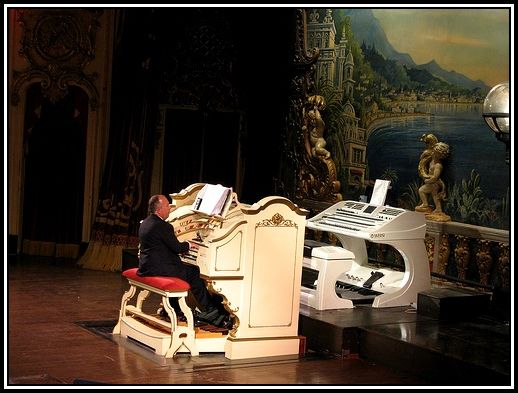 The Wurlitzer Theatre Organ of The Blackpool Tower Ballroom (Opus 2177; 3-Manuals; 14-Ranks)
The Wurlitzer Theatre Organ of The Blackpool Tower Ballroom (Opus 2177; 3-Manuals; 14-Ranks)
shown here with the Ballroom’s Wersi Organ
-oOo-
SHAE’S THEATER BUFFALO & THE WURLITZER
This Theatre & its Wurlitzer Theatre Organ are discussed on Page 18.
-oOo-
AUDITORIUM THEATER ROCHESTER NY & THE WURLITZER
This Theatre & its Wurlitzer Theatre Organ are discussed on Page 18.
—oooOooo—
—oooOooo—
—oooOooo—

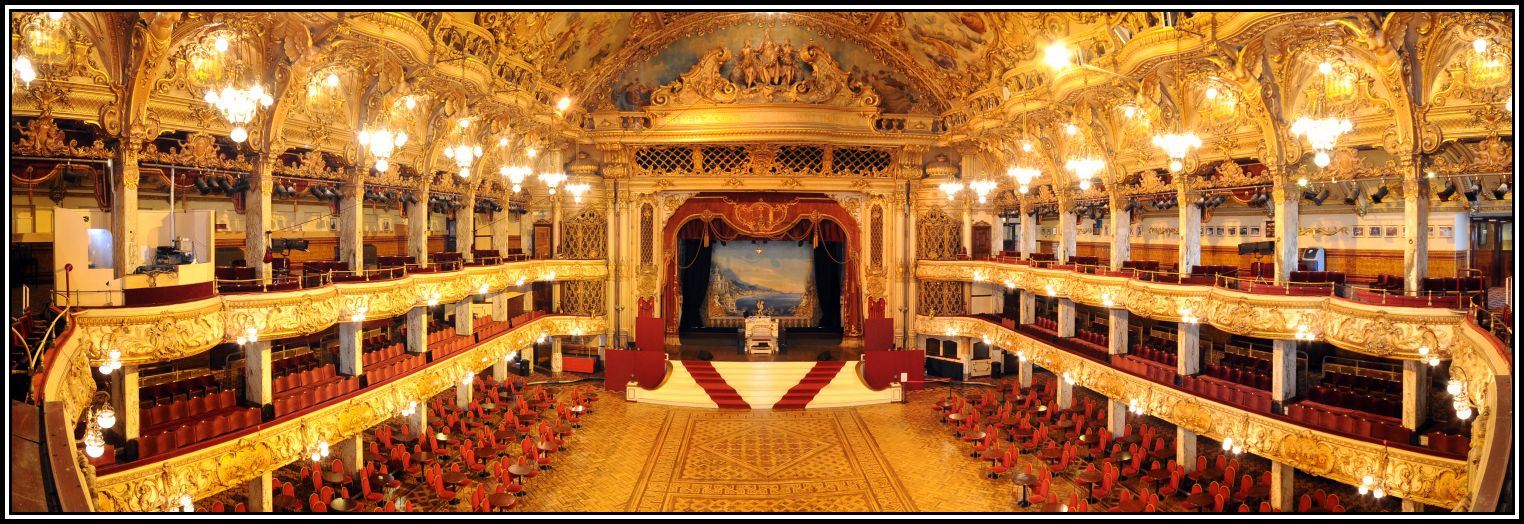 The Blackpool Tower Ballroom
The Blackpool Tower Ballroom